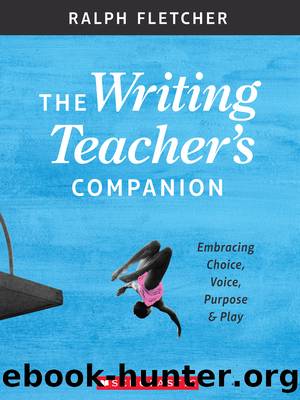The Writing Teacher's Companion by Fletcher Ralph;

Author:Fletcher, Ralph;
Language: eng
Format: epub
Publisher: Scholastic, Incorporated
Published: 2017-08-15T00:00:00+00:00
Ralph on Writing scholastic.com/WritingCompanionResources
I write for two hours every morning,
but itâs what I do the other
22 hours that allows
me to do that writing.
âDON MURRAY
22
Prewriting
Iâll admit it: I have a slightly hostile attitude toward prewriting. But before we get to that, let me extol its virtues, or at least acknowledge them. This initial writing stage has also been called brainstorming or rehearsing. Itâs the activity we undertake leading up to the actual writing itself: making a list, scribbling a phrase or idea as a mental placeholder, sketching images, doodling, trying out a sample chapter for a memoir. J.K. Rowling famously jotted her initial thoughts about Harry Potter on a napkin while sitting in a diner.
Prewriting certainly is an important part of what writers do. As weâve already seen, Iâm a huge proponent of the writerâs notebook, which is in itself a powerful tool for prewriting. Okay, Ralph, so why the attitude?
Because I believe writing teachers overemphasize prewriting, and give it too much weight. Itâs commonplace for a teacher to impose a single prewriting strategy, format, or worksheet that all students are required to use. Before they start writing, the students must fill out a graphic organizer, web, story map, or outline. Many kids find this requirement tedious. At any rate, it does not reflect best practice or common sense. Kids have a certain amount of âjuiceâ to work on a particular piece of writingâif they spend it all on the prewrite, what will they have left for the writing itself?
A rigid adherence to any one prewriting strategy distorts the creative process. People who rely heavily on prewriting believe that writers are people who first plan out the writing and then execute the plan. But what about discovering what you have to say in the act of writing? A few years ago, Neil Gaiman was the featured speaker at a Young Authors conference. After completing his talk, he took a few questions from the audience.
âMr. Gaiman, do you plan out your books first?â one girl wanted to know. âBecause our teacher says if you donât plan first then youâre just winging it.â
Gaiman smiled cheerfully. âWell then, I guess Iâm winging it!â
I was winging it, more or less, when I began writing this book. Itâs true that I had a sketchy idea of what I wanted to include, what tone I wanted to use, but not much more than that.
âI canât give you a Table of Contents until I write the chapters,â I told my editor. I had to write in order to find out what I had to say. Most writers will tell you something similar, that they are guided by an Iâm-figuring-it-out-as-I-go approach, feeling their way down a dark tunnel.
How then should we teach prewriting in the writing classroom? Should we teach it at all? Certainly, yes. Use the mini-lesson to share a variety of prewriting strategies. One day you might show how making a list can help clarify your thinking. Donât talk theoretically about this ideaâmodel it, using a large chart, showing students how you have found it useful.
Download
This site does not store any files on its server. We only index and link to content provided by other sites. Please contact the content providers to delete copyright contents if any and email us, we'll remove relevant links or contents immediately.
Macmillan Primary Grammar 2 Pupil's Book by Unknown(379)
Figuring Out Fluency in Mathematics Teaching and Learning, Grades K-8 by Jennifer M. Bay-Williams & John J. SanGiovanni(343)
The Principal's Guide to Curriculum Leadership by Sorenson Richard D.;Goldsmith Lloyd M.;Mendez Zulma Y.;Maxwell Karen T.;(266)
English Grammar Practice--The Noun by Roxana Nastase(228)
Learning from Accidents 3rd ed by Trevor Kletz (2001)(226)
Harnessing Technology for Deeper Learning by Scott McLeod(215)
Text-Dependent Questions, Grades K-5 by Douglas Fisher & Nancy Frey & Heather Anderson & Marisol Thayre(211)
A Guide to Curriculum Mapping by Hale Janet A.;(202)
English Language Program Administration by Unknown(199)
Deep Change Leadership by Reeves Douglas;(190)
How to Do Everything with Google Tools by Unknown(188)
The Grammar Teacher's Activity-a-Day by Jack Umstatter(178)
The Power of SMART Goals by Conzemius Anne;O'Neill Jan; & Anne Conzemius(177)
Beyond the RTI Pyramid by Bender William N.;(158)
Aligning and Balancing the Standards-Based Curriculum by Squires David A.;(156)
Using Data to Close the Achievement Gap by Johnson Ruth S.;(156)
Using Equity Audits to Create Equitable and Excellent Schools by Skrla Linda E.;McKenzie Kathryn B.;Scheurich James Joseph;(151)
Differentiated Instructional Strategies for the Block Schedule by Gregory Gayle H.;Herndon Lynne E.; & Lynne E. Herndon(145)
You've Got to Reach Them to Teach Them by Schreck Mary Kim; & Schreck(140)
